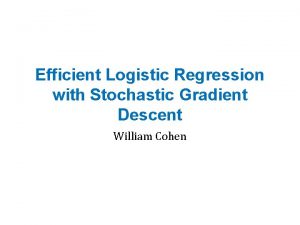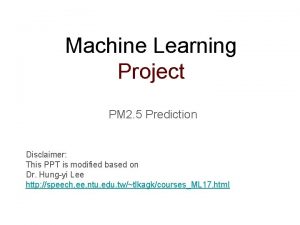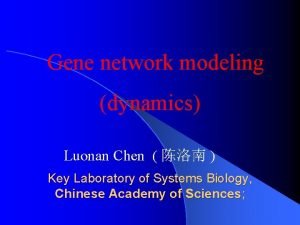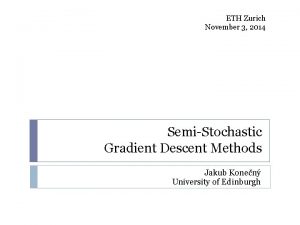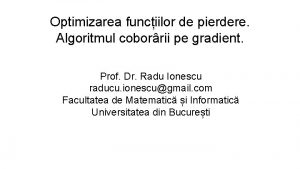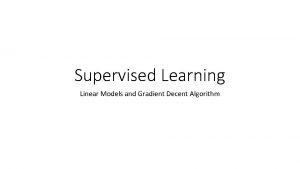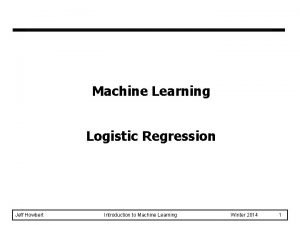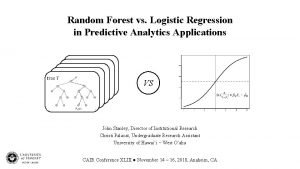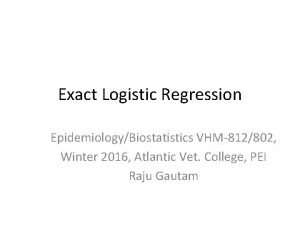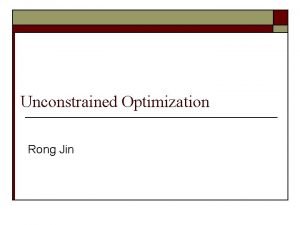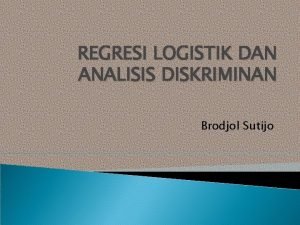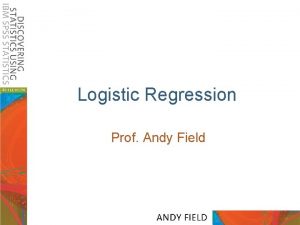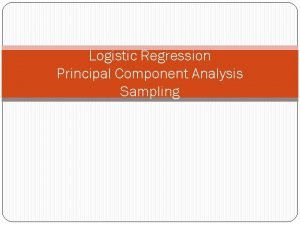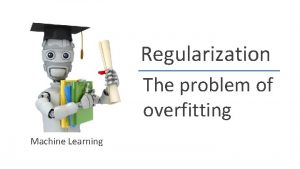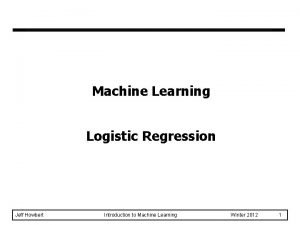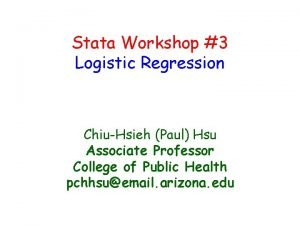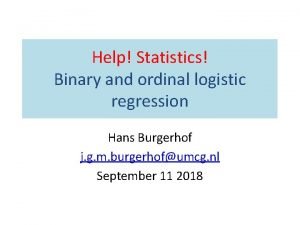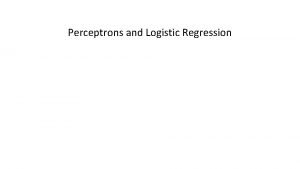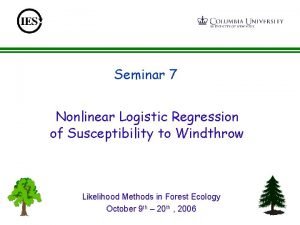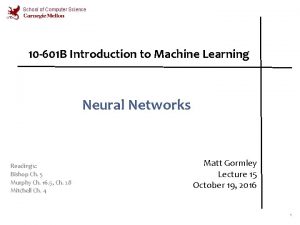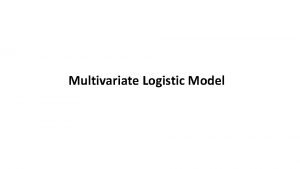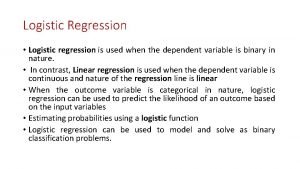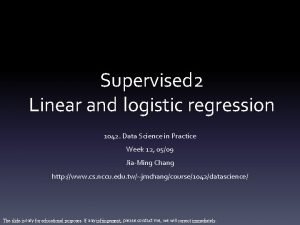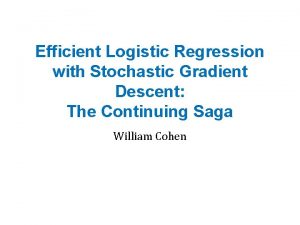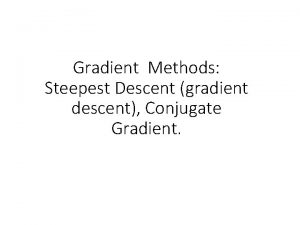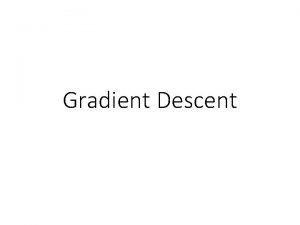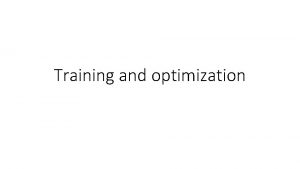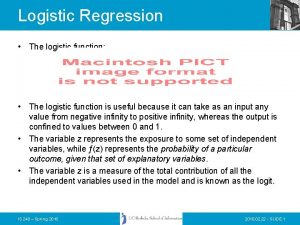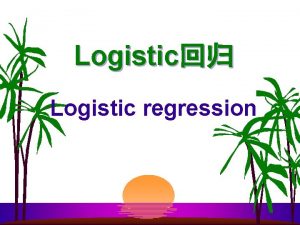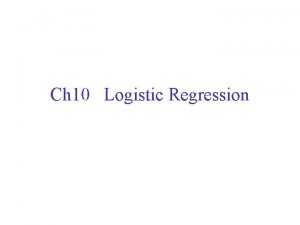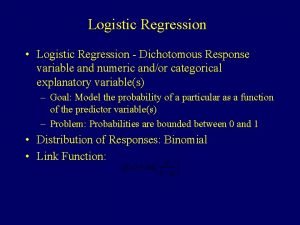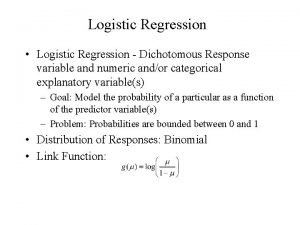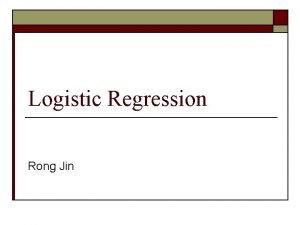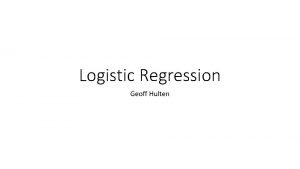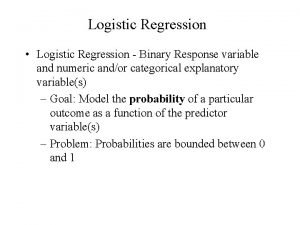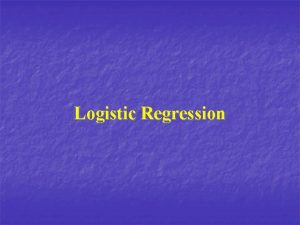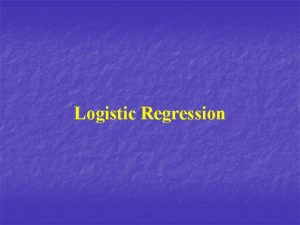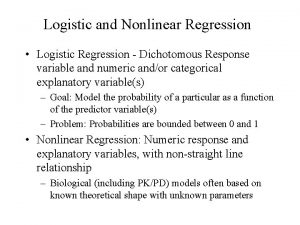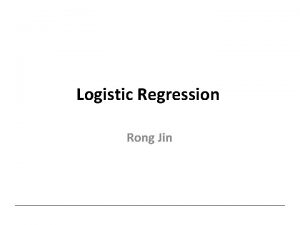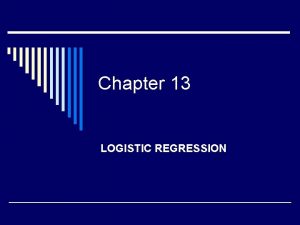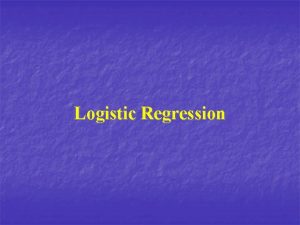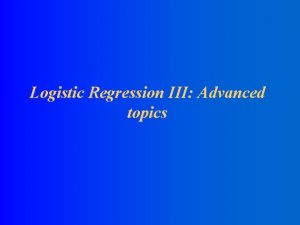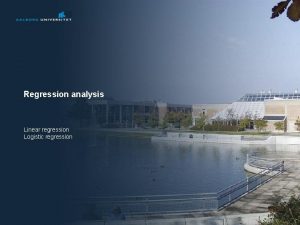Efficient Logistic Regression with Stochastic Gradient Descent William















![A possible SGD implementation • Parameter settings: – W[j] *= (1 - λ 2μ)k-A[j] A possible SGD implementation • Parameter settings: – W[j] *= (1 - λ 2μ)k-A[j]](https://slidetodoc.com/presentation_image_h2/8fe1f2c45c881f6a6dc6164006a4cb62/image-16.jpg)


















- Slides: 34

Efficient Logistic Regression with Stochastic Gradient Descent William Cohen 1

SGD FOR LOGISTIC REGRESSION 2

SGD for Logistic regression • Start with Rocchio-like linear classifier: • Replace sign(. . . ) with something differentiable: – Also scale from 0 -1 not -1 to +1 • Decide to optimize: • Differentiate…. 3

Magically, when we differentiate, we end up with something very simple and elegant…. . The update for gradient descent with rate λ is just: 4

An observation: sparsity! Key computational point: • if xj=0 then the gradient of wj is zero • so when processing an example you only need to update weights for the non-zero features of an example. 5

SGD for logistic regression • The algorithm: -- do this in random order 6

Adding regularization • Replace LCL • with LCL + penalty for large weights, eg • So: • becomes: 7

Regularized logistic regression • Replace LCL • with LCL + penalty for large weights, eg • So the update for wj becomes: • Or 8

Naively this is not a sparse update • Algorithm: Time goes from O(n. T) to O(m. VT) where • n = number of non-zero entries, • m = number of examples • V = number of features • T = number of passes over data 9

Sparse regularized logistic regression • Final algorithm: • Initialize hashtables W, A and set k=0 • For each iteration t=1, …T • • – For each example (xi, yi) • pi = … ; k++ • • For each non-zero feature W[j] – W[j] *= (1 - λ 2μ)k-A[j] – W[j] = W[j] + λ(yi - pi)xj – A[j] = k k = “clock” reading A[j] = clock reading last time feature j was “active” we implement the “weight decay” update using a “lazy” strategy: weights are decayed in one shot when a feature is “active” 10

Sparse regularized logistic regression (v 2) • Initialize hashtables W, A and set k=0 • For each iteration t=1, …T – For each example (xi, yi) • k++ ** • For each non-zero feature W[j] – W[j] *= (1 - λ 2μ)k-A[j] • pi = … • For each non-zero feature W[j] – W[j] = W[j] + λ(yi - pi)xj – A[j] = k • k = “clock” reading • A[j] = clock reading last time feature j was “active” • we implement the “weight decay” update using a “lazy” strategy: weights are decayed in one shot when a feature is “active” • Finally: – Before you write out each W[j] do ** 11

Summary • What’s happened here: – Our update involves a sparse part and a dense part • Sparse: empirical loss on this example • Dense: regularization loss – not affected by the example – We remove the dense part of the update • Old example update: – for each feature { do something example-independent} – For each active feature { do something example-dependent} • New example update: – For each active feature : » {simulate the prior example-independent updates} » {do something example-dependent} 12

Summary • We can separate the LCL update and weight decay updates but remember: – we need to apply “weight decay” to just the active features in an example xi before we compute the prediction pi – we need to apply “weight decay” to all features before we save the classifier – my suggestion: • an abstraction for a logistic regression classifier

A possible SGD implementation class SGDLogistic Regression { /** Predict using current weights **/ double predict(Map features); /** Apply weight decay to a single feature and record when in A[ ]**/ void regularize(string feature, int current. K); /** Regularize all features then save to disk **/ void save(string file. Name, int current. K); /** Load a saved classifier **/ static SGDClassifier load(String file. Name); /** Train on one example **/ void train 1(Map features, double true. Label, int k) { // regularize each feature // predict and apply update } } // main ‘train’ program assumes a stream of randomly-ordered examples and outputs classifier to disk; main ‘test’ program prints predictions for each test case in input.

A possible SGD implementation class SGDLogistic Regression { … } // main ‘train’ program assumes a stream of randomly-ordered examples and outputs classifier to disk; main ‘test’ program prints predictions for each test case in input. <100 lines (in python) Other mains: • A “shuffler: ” – stream thru a training file T times and output instances – output is randomly ordered, as much as possible, given a buffer of size B • Something to collect predictions + true labels and produce error rates, etc.
![A possible SGD implementation Parameter settings Wj 1 λ 2μkAj A possible SGD implementation • Parameter settings: – W[j] *= (1 - λ 2μ)k-A[j]](https://slidetodoc.com/presentation_image_h2/8fe1f2c45c881f6a6dc6164006a4cb62/image-16.jpg)
A possible SGD implementation • Parameter settings: – W[j] *= (1 - λ 2μ)k-A[j] – W[j] = W[j] + λ(yi - pi)xj • I didn’t tune especially but used – μ=0. 1 – λ=η* E-2 where E is “epoch”, η=½ • epoch: number of times you’ve iterated over the dataset, starting at E=1

BOUNDED-MEMORY LOGISTIC REGRESSION 17

Outline • Logistic regression and SGD – Learning as optimization – Logistic regression: • a linear classifier optimizing P(y|x) – Stochastic gradient descent • “streaming optimization” for ML problems – Regularized logistic regression – Sparse regularized logistic regression – Memory-saving logistic regression 18

Question • In text classification most words are a. rare b. not correlated with any class c. given low weights in the LR classifier d. unlikely to affect classification e. not very interesting 19

Question • In text classification most bigrams are a. rare b. not correlated with any class c. given low weights in the LR classifier d. unlikely to affect classification e. not very interesting 20

Question • Most of the weights in a classifier are – important – not important 21

How can we exploit this? • One idea: combine uncommon words together randomly • Examples: – replace all occurrances of “humanitarianism” or “biopsy” with “humanitarianism. Or. Biopsy” – replace all occurrances of “schizoid” or “duchy” with “schizoid. Or. Duchy” – replace all occurrances of “gynecologist” or “constrictor” with “gynecologist. Or. Constrictor” – … • For Naïve Bayes this breaks independence assumptions – it’s not obviously a problem for logistic regression, though • I could combine – two low-weight words (won’t matter much) – a low-weight and a high-weight word (won’t matter much) – two high-weight words (not very likely to happen) • How much of this can I get away with? – certainly a little – is it enough to make a difference? how much memory does it save? 22

How can we exploit this? • Another observation: – the values in my hash table are weights – the keys in my hash table are strings for the feature names • We need them to avoid collisions • But maybe we don’t care about collisions? – Allowing “schizoid” & “duchy” to collide is equivalent to replacing all occurrences of “schizoid” or “duchy” with “schizoid. Or. Duchy” 23

Learning as optimization for regularized logistic regression • Algorithm: • Initialize hashtables W, A and set k=0 • For each iteration t=1, …T – For each example (xi, yi) • pi = … ; k++ • For each feature j: xij>0: » W[j] *= (1 - λ 2μ)k-A[j] » W[j] = W[j] + λ(yi - pi)xj » A[j] = k 24

Learning as optimization for regularized logistic regression • Algorithm: • Initialize arrays W, A of size R and set k=0 • For each iteration t=1, …T – For each example (xi, yi) • Let V be hash table so that • pi = … ; k++ • For each hash value h: V[h]>0: » W[h] *= (1 - λ 2μ)k-A[j] » W[h] = W[h] + λ(yi - pi)V[h] » A[j] = k 25

Learning as optimization for regularized logistic regression • Algorithm: • Initialize arrays W, A of size R and set k=0 • For each iteration t=1, …T – For each example (xi, yi) • Let V be hash table so that ? ? ? • pi = … ; k++ 26

SOME EXPERIMENTS 27

ICML 2009 28

An interesting example • Spam filtering for Yahoo mail – Lots of examples and lots of users – Two options: • one filter for everyone—but users disagree • one filter for each user—but some users are lazy and don’t label anything – Third option: • • • classify (msg, user) pairs features of message i are words wi, 1, …, wi, ki feature of user is his/her id u features of pair are: wi, 1, …, wi, ki and u wi, 1, …, u wi, ki based on an idea by Hal Daumé 29

An example • E. g. , this email to wcohen • features: – dear, madam, sir, …. investment, broker, …, wcohen dear, wcohen madam, wcohen, …, • idea: the learner will figure out how to personalize my spam filter by using the wcohen X features 30

An example Compute personalized features and multiple hashes on-the-fly: a great opportunity to use several processors and speed up 31 i/o

Experiments • • 3. 2 M emails 40 M tokens 430 k users 16 T unique features – after personalization 32

An example 2^26 entries = 1 Gb @ 8 bytes/weight 33

34
 Gradient descent java
Gradient descent java Gradient descent
Gradient descent Linear regression gradient descent
Linear regression gradient descent Logistic regression vs linear regression
Logistic regression vs linear regression Logistic regression vs linear regression
Logistic regression vs linear regression Stochastic gradient langevin dynamics
Stochastic gradient langevin dynamics Linear regression multiple features
Linear regression multiple features Gradient descent rule
Gradient descent rule Batch gradient descent
Batch gradient descent Kay ousterhout
Kay ousterhout Gradient descent equation
Gradient descent equation Gradient descent python implementation
Gradient descent python implementation Productively efficient vs allocatively efficient
Productively efficient vs allocatively efficient Productively efficient vs allocatively efficient
Productively efficient vs allocatively efficient Productively efficient vs allocatively efficient
Productively efficient vs allocatively efficient Allocative efficiency
Allocative efficiency Allocative efficiency vs productive efficiency
Allocative efficiency vs productive efficiency Advantage of logistic regression
Advantage of logistic regression Logistic regression epidemiology
Logistic regression epidemiology Logistic regression in predictive analytics
Logistic regression in predictive analytics Exact logistic regression
Exact logistic regression Hessian matrix for 3 variables
Hessian matrix for 3 variables Logistic regression slide
Logistic regression slide Logistic regression andy field
Logistic regression andy field Pca logistic regression
Pca logistic regression Regularized cost function
Regularized cost function Disadvantages of logistic regression
Disadvantages of logistic regression Logistic regression stata
Logistic regression stata Hans burgerhof
Hans burgerhof Perceptron logistic regression
Perceptron logistic regression Nonlinear logistic regression
Nonlinear logistic regression 601(b)(10)
601(b)(10) Ratio test
Ratio test Logistic function
Logistic function Logistic regression residual deviance
Logistic regression residual deviance
